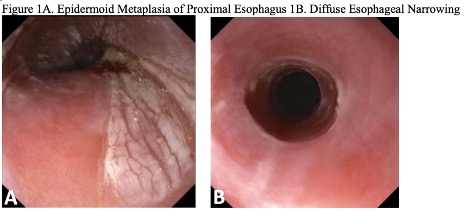Monday Poster Session
Category: Esophagus
P2871 - Concurrent Lymphocytic Esophagitis and Epidermoid Metaplasia in the Esophagus: A Diagnostic Challenge
Monday, October 27, 2025
10:30 AM - 4:00 PM PDT
Location: Exhibit Hall
- SL
Susie Lee, MD
Keck School of Medicine of the University of Southern California
Los Angeles, CA
Presenting Author(s)
Susie Lee, MD, Anisa Shaker, MD, Edy Soffer, MD
Keck School of Medicine of the University of Southern California, Los Angeles, CA
Introduction: Lymphocytic esophagitis (LyE) is a rare esophageal inflammatory condition, histologically characterized by a dense peripapillary lymphocytic infiltrate with minimal granulocytes. While its etiology remain uncertain, LyE has been increasingly recognized in association with various esophageal symptoms, including dysphagia and food impaction. Esophageal epidermoid metaplasia (esophageal leukoplakia) is a rare condition with potential progression to squamous cell carcinoma. The coexistence of LyE and epidermoid metaplasia is exceedingly rare and has not been well documented in the literature. We present a unique case highlighting this rare histologic combination.
Case Description/
Methods: An 83-year-old female with past medical history of GERD, arthritis, and coronary artery disease presented with dysphagia 4 years ago. Initial EGD revealed diffuse esophageal rings and gastric erythema. Repeat EGD 2 years ago showed esophageal strictures and esophageal biopsies showed epidermoid metaplasia. Balloon dilation provided temporary improvement in dysphagia and she was referred to our medical center for further care.
We proceeded with an esophagram that showed diffuse esophageal narrowing without evidence of focal strictures and esophageal dysmotility. Esophageal manometry showed hypercontractile esophagus and esophagogastric junction outflow obstruction (EGJOO). An EGD showed diffuse esophageal narrowing and an area consistent with esophageal leukoplakia. Esophageal biopsies showed lymphocytic esophagitis and epidermoid metaplasia. The patient was offered esophageal bougie dilation but declined out of concern for complications.
Discussion: This case highlights a rare and clinically complex presentation involving both LyE and epidermoid metaplasia – two uncommon histologic findings in the esophagus with unclear etiologies and limited data on their coexistence. The patient's symptoms of dysphagia, alongside findings of esophageal narrowing, EGJ outflow obstruction and hypercontractile motility, point to a multifactorial process involving inflammatory, structural, and functional components. The presence of both entities in this patient may reflect a shared underlying pathogenesis driven by chronic esophageal injury. Further research is needed to better understand the clinical significance, optimal management, and long-term outcomes in patients with this histologic overlap.

Figure: Figure 1A. Epidermoid Metaplasia of Proximal Esophagus 1B. Diffuse Esophageal Narrowing

Figure: Figure 2. Diffuse Esophageal Narrowing in Esophagram
Disclosures:
Susie Lee indicated no relevant financial relationships.
Anisa Shaker indicated no relevant financial relationships.
Edy Soffer indicated no relevant financial relationships.
Susie Lee, MD, Anisa Shaker, MD, Edy Soffer, MD. P2871 - Concurrent Lymphocytic Esophagitis and Epidermoid Metaplasia in the Esophagus: A Diagnostic Challenge, ACG 2025 Annual Scientific Meeting Abstracts. Phoenix, AZ: American College of Gastroenterology.
Keck School of Medicine of the University of Southern California, Los Angeles, CA
Introduction: Lymphocytic esophagitis (LyE) is a rare esophageal inflammatory condition, histologically characterized by a dense peripapillary lymphocytic infiltrate with minimal granulocytes. While its etiology remain uncertain, LyE has been increasingly recognized in association with various esophageal symptoms, including dysphagia and food impaction. Esophageal epidermoid metaplasia (esophageal leukoplakia) is a rare condition with potential progression to squamous cell carcinoma. The coexistence of LyE and epidermoid metaplasia is exceedingly rare and has not been well documented in the literature. We present a unique case highlighting this rare histologic combination.
Case Description/
Methods: An 83-year-old female with past medical history of GERD, arthritis, and coronary artery disease presented with dysphagia 4 years ago. Initial EGD revealed diffuse esophageal rings and gastric erythema. Repeat EGD 2 years ago showed esophageal strictures and esophageal biopsies showed epidermoid metaplasia. Balloon dilation provided temporary improvement in dysphagia and she was referred to our medical center for further care.
We proceeded with an esophagram that showed diffuse esophageal narrowing without evidence of focal strictures and esophageal dysmotility. Esophageal manometry showed hypercontractile esophagus and esophagogastric junction outflow obstruction (EGJOO). An EGD showed diffuse esophageal narrowing and an area consistent with esophageal leukoplakia. Esophageal biopsies showed lymphocytic esophagitis and epidermoid metaplasia. The patient was offered esophageal bougie dilation but declined out of concern for complications.
Discussion: This case highlights a rare and clinically complex presentation involving both LyE and epidermoid metaplasia – two uncommon histologic findings in the esophagus with unclear etiologies and limited data on their coexistence. The patient's symptoms of dysphagia, alongside findings of esophageal narrowing, EGJ outflow obstruction and hypercontractile motility, point to a multifactorial process involving inflammatory, structural, and functional components. The presence of both entities in this patient may reflect a shared underlying pathogenesis driven by chronic esophageal injury. Further research is needed to better understand the clinical significance, optimal management, and long-term outcomes in patients with this histologic overlap.

Figure: Figure 1A. Epidermoid Metaplasia of Proximal Esophagus 1B. Diffuse Esophageal Narrowing

Figure: Figure 2. Diffuse Esophageal Narrowing in Esophagram
Disclosures:
Susie Lee indicated no relevant financial relationships.
Anisa Shaker indicated no relevant financial relationships.
Edy Soffer indicated no relevant financial relationships.
Susie Lee, MD, Anisa Shaker, MD, Edy Soffer, MD. P2871 - Concurrent Lymphocytic Esophagitis and Epidermoid Metaplasia in the Esophagus: A Diagnostic Challenge, ACG 2025 Annual Scientific Meeting Abstracts. Phoenix, AZ: American College of Gastroenterology.
